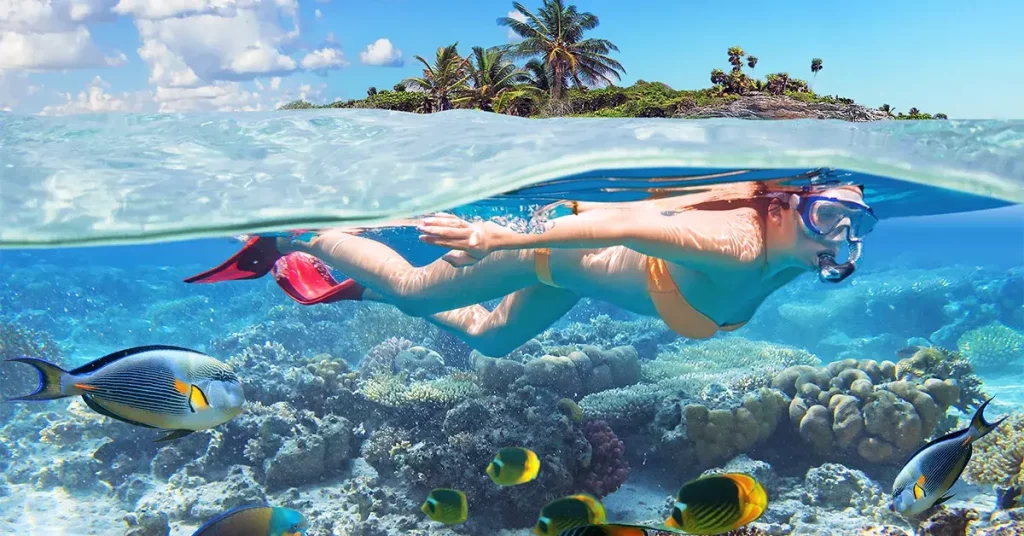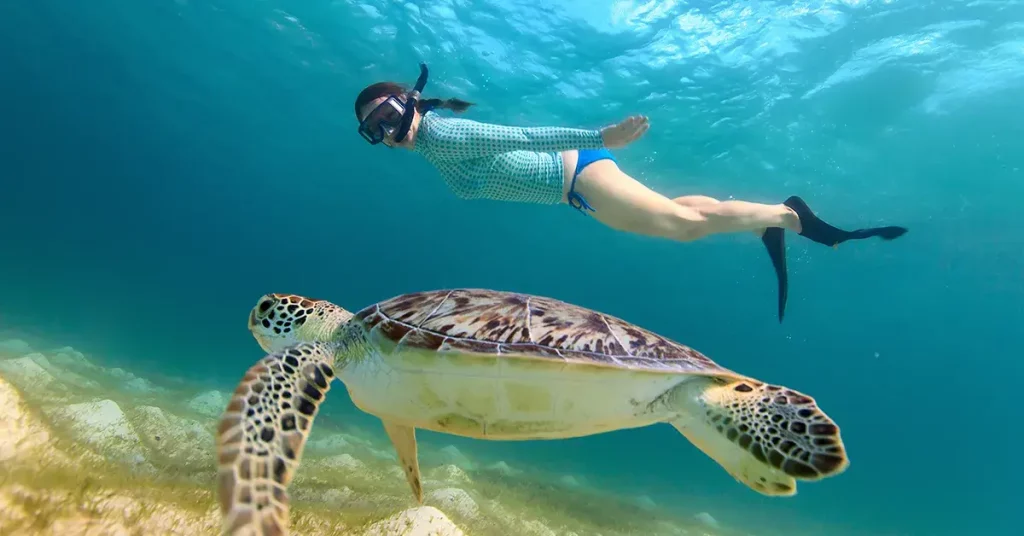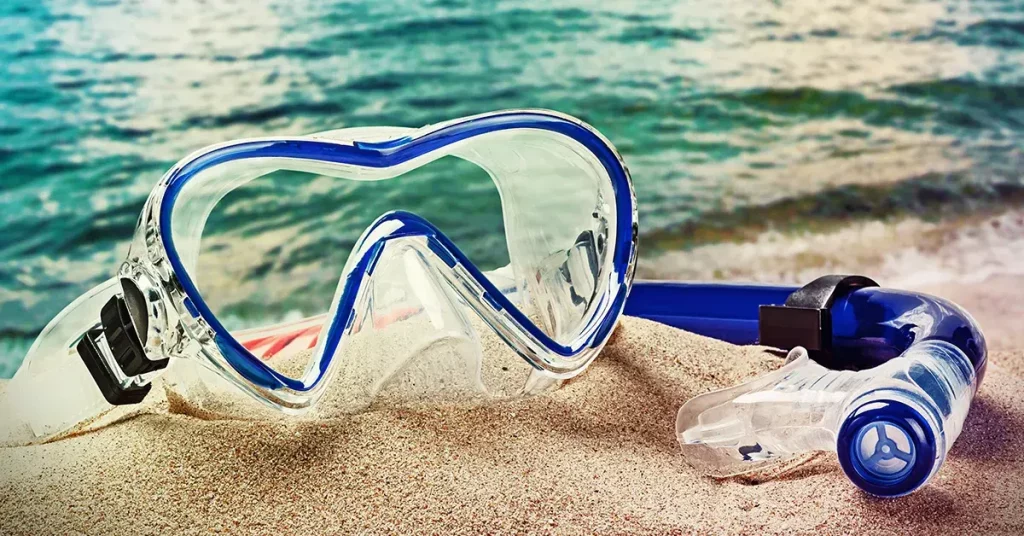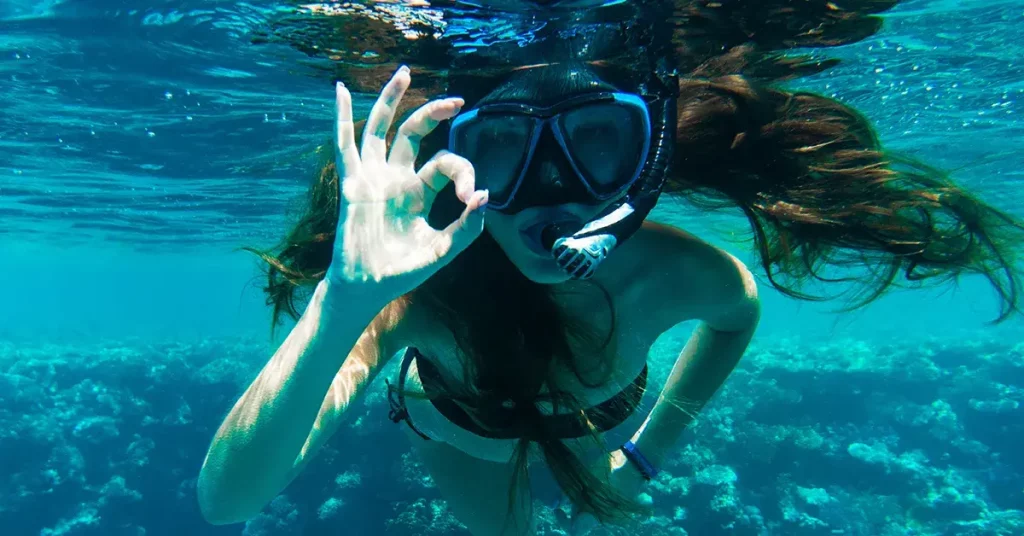You’re ready to snorkel but you’re unsure how to breathe while snorkeling. Is it possible to get enough air in and out of that tiny tube? What happens if there is water in the tube? Can I breathe through a snorkel? Let’s find out!
Before You Snorkel

If you are a first-timer, wondering how to breathe while snorkeling is a normal.
Breathing through a snorkel is slightly different from when you are on land. You have to be more intentional with your breathing. And, if you don’t know how to swim, take a few swimming lessons before diving into open water for the first time.
Before utilizing a snorkel, you need first learn how to breathe while swimming. Breath control provides three important tasks once a snorkel is added to the equation:
- Breathe deeply to ensure you get enough fresh air.
- Avoid swallowing water through your snorkel.
- Adjust your breathing to control your buoyancy.
Each of these roles signifies a step further in your breath control mastery.
Take Deep Breaths

To learn breathing underwater, the first step is to become more conscious of your breathing. Take a few moments to marvel at how intricate your breathing is! What is the depth of your inhalation and exhalation? Do you inhale through your mouth, nose, or both? When you breathe, which parts of your body move the most? Can you control how much your chest expands in comparison to your belly? Yes, a lot is going on!
Most people have shallow breaths during normal breathing. Because your body is not active, you are not exchanging a lot of air throughout each ventilation cycle. Even little exercise causes you to breathe more deeply to exchange more air and provide more oxygen to your muscles. Snorkeling is no different, but because you’ll be dealing with water and a tube, it’ll be better to practice deep breathing consciously on land before hitting the water.
Learn Deep Breathing and Breathing Slowly
It would help if you learned to consciously take deep and steady breaths instead of the shallow, often inconsistent ones you take on land. That allows the most air to enter your lungs while also ensuring that stale air is thoroughly expelled from the snorkel tube on exhale.
Each cycle of deep breathing entails inhaling and exhaling more deeply. In other words, each time you breathe, you’re exchanging more air in your lungs. As a result, deep breathing necessitates more diaphragmatic involvement than typical breathing. Experts suggest that for deep breathing, on each inhale and exhale, a count of 4 to 8. You can also take deep breathing exercises.
Deeper, more intentional breaths will make your lungs more elastic, allowing you to breathe deeper even at rest. They assist lower blood pressure and heart rate by toning your diaphragm and intercostal muscles. As a result, they’re an excellent addition to any exercise or athletics training. Practicing yoga is a fantastic way to teach your body how to breathe deeply.
It’s crucial to learn to breathe deeply while snorkeling to get more fresh air. Each time you breathe, deep breathing guarantees that all of the air in your snorkel tube is exchanged. While snorkeling, some people may feel tired, dizzy, or acquire a minor headache. That is most likely due to not breathing deeply enough, which causes “stale air” to build up in the tube, with a higher carbon dioxide level.
Underwater Breathing

Unfortunately, if you’re snorkeling, water will enter your mouth at some time. It doesn’t mean your snorkeling gear is faulty, there’s just no way around it. You’ll learn how to comfortably deal with water without panicking or accidentally inhaling it.
What to expect
Water will gather in your snorkel’s reservoir. That can sometimes result in a lapping or popping sound when breathing, which many snorkelers find alarming at first.
When the water level rises, rookie snorkelers may inadvertently inhale part of it, resulting in coughing. How do professional snorkelers handle water in the snorkel?
Here are some tips from the pros:
- You will become accustomed to having only a limited amount of water in your snorkel reservoir.
- You’re less likely to suck water from the reservoir into your mouth if you take the calm, regulated inhales and breath slowly and deeply.
- Consider getting a full face snorkel mask as this are easier to breathe underwater.
Clear Your Flooded Snorkel

Snorkel clearing is the act of expelling excess water from the snorkel tube with a vigorous exhale. If you’re using a snorkel with a purge valve, you may evacuate water from the bottom of the tube instead of forcing it entirely out the top. Also, some snorkels come with a splash guard, to help.
Breathing control is crucial in this situation as well. If your snorkel floods inadvertently, you will not inhale any of the water and have enough air in your lungs to purge the snorkel.
How it works
The greatest method to improve your snorkel clearing skills is to practice. Try it out using a pool because you’ll be in a more regulated environment. If you’re in open water, make sure it’s shallow enough so you l can securely stand if required.
To clear a flooded snorkel tube, use these steps:
- Make sure your snorkel mask fits tightly (Tip: try a full face snorkel mask)
- Take a deep breath and bob your head beneath the water to flood the snorkel tube.
- Hold your breath and keep the snorkel saturated for a few seconds.
- Exhale deeply and puffingly to shunt the water out of the tube, either through the purge valve if you are using a semi dry snorkel or out the top if you are using a dry snorkel.
- Take slow breaths, inhale gently and exhale slowly.
- Inhale carefully after clearing.
Maintain Buoyancy

With your snorkel, you’ve learned how to relax and breathe deeply. You’ve also mastered dealing with water in your snorkel/mouth to the point that it no longer bothers you.
Now, it’s time to add a new dimension to your breathing: buoyancy control.
You might think that buoyancy management is something that only scuba divers have to deal with, but this isn’t the case! Good buoyancy control is beneficial to everyone who engages in any water-based activity. Whether you’re snorkeling, scuba diving, or just swimming, precisely adjusting your location in water using your lungs is a skill that will boost your confidence, enjoyment and conserve energy.
Snorkelers need to be aware of buoyancy management since it impacts their position in the water and allows you to float comfortably. You’ll need superb buoyancy control if you want to go up close to coral reefs and marine life like sea turtles without unintentionally contacting or bumping against anything.
You’ll save energy by treading with your arms and legs if you rely on your lungs to keep your vertical posture under control. This will keep you from getting tired, and it will also allow you to avoid injuring the coral reef by accident.
How to stay buoyant
Your legs should be straight behind you, your head should be looking down and slightly forward, and your arms should be at your sides or softly clasped in front of you for optimal buoyancy control.
Your lungs function as a natural buoyancy control system! Exhale fully for one or two breaths, with normal or shallow inhales in between, to lower yourself slightly. You’ll be able to completely submerge your body and glide slightly beneath the waterline in that position.
Do the reverse to float back to the surface: inhale deeply for a few breaths, followed by normal or shallow exhales. For new snorkelers, wearing a snorkeling vest can help out a lot with the added benefit of keeping you cool even in warm water.
Snorkel Like a Pro

As you can see, breathing using a snorkel entails more than simply putting a tube in your mouth and breathing.
Keep the following principles in mind when snorkeling to manage your breathing:
- Take controlled breaths to properly exchange the air in your snorkel tube on each ventilation cycle and improve your lung capacity.
- To maintain your snorkel above the waterline, streamline your body and look down and slightly forward when in the water.
- There will always be excess water in your snorkel reservoir or snorkel loop like in traditional snorkels.
- Flooding and clearing your snorkel is something you’ll have to do. It would become second nature after some practice.
- Change the way you breathe to practice managing your buoyancy.
- Don’t rely on your arms to maintain your underwater position.
- Relax!
Conclusion
As you can see, there is a right technique to breathe while breathing through a snorkel, and it isn’t difficult. At the very least, remember to breathe slowly and don’t take shallow breaths.
Breathing using a snorkel will take some practice before becoming second nature to you. Because we are accustomed to breathing via our nose, the first few times may seem strange. Furthermore, the greater resistance may cause you to strain your lungs when you first begin. Keep these pointers in mind, and you’ll be able dive underwater to enjoy the underwater environment and the numerous health advantages that experienced snorkelers enjoy, so feel free to take that snorkeling trip!




